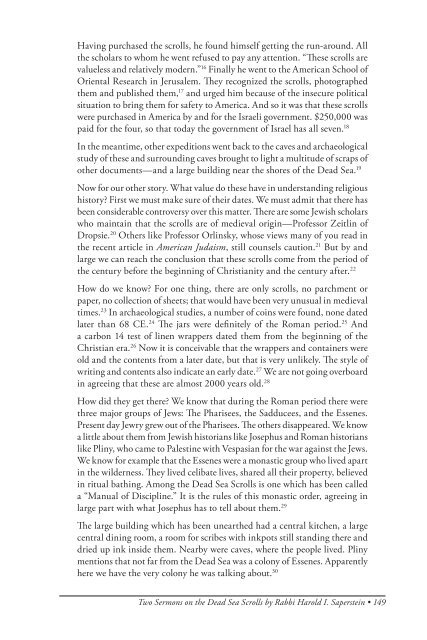The American Jewish Archives Journal, Volume LXI 2009, Number 1
The American Jewish Archives Journal, Volume LXI 2009, Number 1
The American Jewish Archives Journal, Volume LXI 2009, Number 1
Create successful ePaper yourself
Turn your PDF publications into a flip-book with our unique Google optimized e-Paper software.
Having purchased the scrolls, he found himself getting the run-around. All<br />
the scholars to whom he went refused to pay any attention. “<strong>The</strong>se scrolls are<br />
valueless and relatively modern.” 16 Finally he went to the <strong>American</strong> School of<br />
Oriental Research in Jerusalem. <strong>The</strong>y recognized the scrolls, photographed<br />
them and published them, 17 and urged him because of the insecure political<br />
situation to bring them for safety to America. And so it was that these scrolls<br />
were purchased in America by and for the Israeli government. $250,000 was<br />
paid for the four, so that today the government of Israel has all seven. 18<br />
In the meantime, other expeditions went back to the caves and archaeological<br />
study of these and surrounding caves brought to light a multitude of scraps of<br />
other documents—and a large building near the shores of the Dead Sea. 19<br />
Now for our other story. What value do these have in understanding religious<br />
history? First we must make sure of their dates. We must admit that there has<br />
been considerable controversy over this matter. <strong>The</strong>re are some <strong>Jewish</strong> scholars<br />
who maintain that the scrolls are of medieval origin—Professor Zeitlin of<br />
Dropsie. 20 Others like Professor Orlinsky, whose views many of you read in<br />
the recent article in <strong>American</strong> Judaism, still counsels caution. 21 But by and<br />
large we can reach the conclusion that these scrolls come from the period of<br />
the century before the beginning of Christianity and the century after. 22<br />
How do we know? For one thing, there are only scrolls, no parchment or<br />
paper, no collection of sheets; that would have been very unusual in medieval<br />
times. 23 In archaeological studies, a number of coins were found, none dated<br />
later than 68 CE. 24 <strong>The</strong> jars were definitely of the Roman period. 25 And<br />
a carbon 14 test of linen wrappers dated them from the beginning of the<br />
Christian era. 26 Now it is conceivable that the wrappers and containers were<br />
old and the contents from a later date, but that is very unlikely. <strong>The</strong> style of<br />
writing and contents also indicate an early date. 27 We are not going overboard<br />
in agreeing that these are almost 2000 years old. 28<br />
How did they get there? We know that during the Roman period there were<br />
three major groups of Jews: <strong>The</strong> Pharisees, the Sadducees, and the Essenes.<br />
Present day Jewry grew out of the Pharisees. <strong>The</strong> others disappeared. We know<br />
a little about them from <strong>Jewish</strong> historians like Josephus and Roman historians<br />
like Pliny, who came to Palestine with Vespasian for the war against the Jews.<br />
We know for example that the Essenes were a monastic group who lived apart<br />
in the wilderness. <strong>The</strong>y lived celibate lives, shared all their property, believed<br />
in ritual bathing. Among the Dead Sea Scrolls is one which has been called<br />
a “Manual of Discipline.” It is the rules of this monastic order, agreeing in<br />
large part with what Josephus has to tell about them. 29<br />
<strong>The</strong> large building which has been unearthed had a central kitchen, a large<br />
central dining room, a room for scribes with inkpots still standing there and<br />
dried up ink inside them. Nearby were caves, where the people lived. Pliny<br />
mentions that not far from the Dead Sea was a colony of Essenes. Apparently<br />
here we have the very colony he was talking about. 30<br />
Two Sermons on the Dead Sea Scrolls by Rabbi Harold I. Saperstein • 149

















